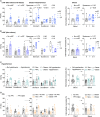Obesity in Humans Is Characterized by Gut Inflammation as Shown by Pro-Inflammatory Intestinal Macrophage Accumulation
- PMID: 34054838
- PMCID: PMC8158297
- DOI: 10.3389/fimmu.2021.668654
Obesity in Humans Is Characterized by Gut Inflammation as Shown by Pro-Inflammatory Intestinal Macrophage Accumulation
Abstract
Chronic low-grade inflammation is a hallmark of obesity and associated with cardiovascular complications. However, it remains unclear where this inflammation starts. As the gut is constantly exposed to food, gut microbiota, and metabolites, we hypothesized that mucosal immunity triggers an innate inflammatory response in obesity. We characterized five distinct macrophage subpopulations (P1-P5) along the gastrointestinal tract and blood monocyte subpopulations (classical, non-classical, intermediate), which replenish intestinal macrophages, in non-obese (BMI<27kg/m2) and obese individuals (BMI>32kg/m2). To elucidate factors that potentially trigger gut inflammation, we correlated these subpopulations with cardiovascular risk factors and lifestyle behaviors. In obese individuals, we found higher pro-inflammatory macrophages in the stomach, duodenum, and colon. Intermediate blood monocytes were also increased in obesity, suggesting enhanced recruitment to the gut. We identified unhealthy lifestyle habits as potential triggers of gut and systemic inflammation (i.e., low vegetable intake, high processed meat consumption, sedentary lifestyle). Cardiovascular risk factors other than body weight did not affect the innate immune response. Thus, obesity in humans is characterized by gut inflammation as shown by accumulation of pro-inflammatory intestinal macrophages, potentially via recruited blood monocytes. Understanding gut innate immunity in human obesity might open up new targets for immune-modulatory treatments in metabolic disease.
Keywords: Obesity; chronic inflammation; diabetes; intestinal inflammation; macrophages; metabolic disease; monocytes; mucosal immunity.
Copyright © 2021 Rohm, Fuchs, Müller, Keller, Baumann, Bosch, Schneider, Labes, Langer, Pilz, Niess, Delko, Hruz and Cavelti-Weder.
Conflict of interest statement
The authors declare that the research was conducted in the absence of any commercial or financial relationships that could be construed as a potential conflict of interest.
Figures





Similar articles
-
Immunometabolism of obesity and diabetes: microbiota link compartmentalized immunity in the gut to metabolic tissue inflammation.Clin Sci (Lond). 2015 Dec;129(12):1083-96. doi: 10.1042/CS20150431. Clin Sci (Lond). 2015. PMID: 26464517 Review.
-
Bifidobacterium pseudocatenulatum CECT 7765 Reduces Obesity-Associated Inflammation by Restoring the Lymphocyte-Macrophage Balance and Gut Microbiota Structure in High-Fat Diet-Fed Mice.PLoS One. 2015 Jul 10;10(7):e0126976. doi: 10.1371/journal.pone.0126976. eCollection 2015. PLoS One. 2015. PMID: 26161548 Free PMC article.
-
Crosstalk between intestinal microbiota, adipose tissue and skeletal muscle as an early event in systemic low-grade inflammation and the development of obesity and diabetes.Diabetes Metab Res Rev. 2015 Sep;31(6):545-61. doi: 10.1002/dmrr.2617. Epub 2014 Dec 8. Diabetes Metab Res Rev. 2015. PMID: 25352002 Review.
-
Diet-induced obesity alters intestinal monocyte-derived and tissue-resident macrophages and increases intestinal permeability in female mice independent of tumor necrosis factor.Am J Physiol Gastrointest Liver Physiol. 2023 Apr 1;324(4):G305-G321. doi: 10.1152/ajpgi.00231.2022. Epub 2023 Feb 7. Am J Physiol Gastrointest Liver Physiol. 2023. PMID: 36749921
-
Diet Rich in Animal Protein Promotes Pro-inflammatory Macrophage Response and Exacerbates Colitis in Mice.Front Immunol. 2019 Apr 26;10:919. doi: 10.3389/fimmu.2019.00919. eCollection 2019. Front Immunol. 2019. PMID: 31105710 Free PMC article.
Cited by
-
Transcriptome of visceral adipose tissue identifies an inflammation-related ceRNA network that regulates obesity.Mol Cell Biochem. 2022 Apr;477(4):1095-1106. doi: 10.1007/s11010-022-04362-y. Epub 2022 Jan 22. Mol Cell Biochem. 2022. PMID: 35064875
-
Inflammation in obesity, diabetes, and related disorders.Immunity. 2022 Jan 11;55(1):31-55. doi: 10.1016/j.immuni.2021.12.013. Immunity. 2022. PMID: 35021057 Free PMC article. Review.
-
Diesel Exhaust Particle (DEP)-induced glucose intolerance is driven by an intestinal innate immune response and NLRP3 activation in mice.Part Fibre Toxicol. 2023 Jul 3;20(1):25. doi: 10.1186/s12989-023-00536-8. Part Fibre Toxicol. 2023. PMID: 37400850 Free PMC article.
-
Targeting colonic macrophages improves glycemic control in high-fat diet-induced obesity.Commun Biol. 2022 Apr 19;5(1):370. doi: 10.1038/s42003-022-03305-z. Commun Biol. 2022. PMID: 35440795 Free PMC article.
-
The Therapeutic Effect of SCFA-Mediated Regulation of the Intestinal Environment on Obesity.Front Nutr. 2022 May 17;9:886902. doi: 10.3389/fnut.2022.886902. eCollection 2022. Front Nutr. 2022. PMID: 35662937 Free PMC article. Review.
References
Publication types
MeSH terms
Substances
LinkOut - more resources
Full Text Sources
Other Literature Sources
Medical
Research Materials
Miscellaneous

